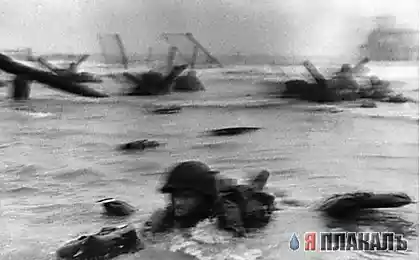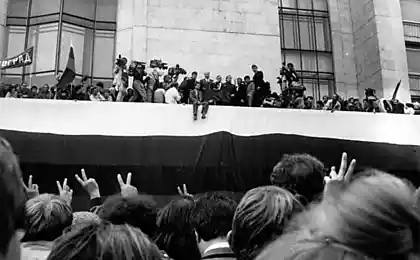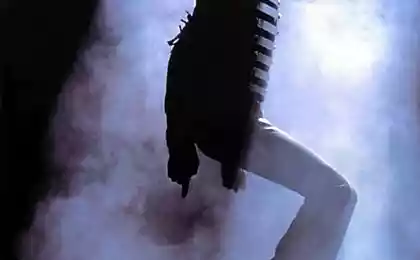1639
13 photos that changed the world (13 photos)
This article was written by an American Ransom Riggs / Ransom Riggs / at the end of 2006 and has since continued to cause a lot of conflicting comments. It is clear that everyone has their own opinion about what is considered a great and what is not. You can argue fiercely and indefinitely and that the entire article focuses only on America, and author of the rest of the world does not see. In addition, there is no Rodchenko or Bresson or Newton. But the images still outstanding. A full objectivity and no one claims.
1. Photography, photographers who raised to new heights.
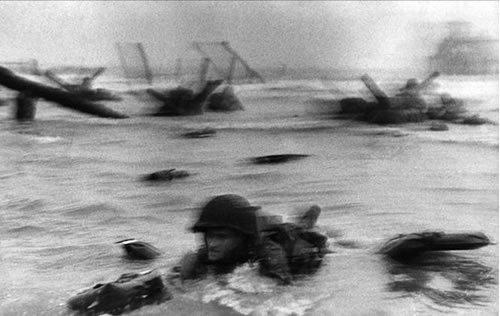
«Omaha Beach, Normandy, France," Robert Capa, 1944
"If your pictures are not good enough, then you are too far away," 'said a military photographer Robert Capa. Pretty tough, but he knew what he was talking about. In the end, his most famous pictures he made June 6, 1944, when he went into the front ranks of the infantry at Omaha Beach. Caught off guard hurricane bombardment, Capa shot in the water until the end of the film. He miraculously managed to get out alive.
Of the four rolls of film that Capa photographed, managed to get only 11 frames -ostalnye spoiled assistant, who tried to show the film in a hurry to catch pass the images to the output of the next issue of the magazine Life.
Ironically, because of the same error remaining pictures got his famous "surreal view" -as wrongly interpreted Life, «slightly out of focus." More than fifty years later, director Steven Spielberg will make a huge effort to reproduce the same "wrong" effect in the film "Saving Private Ryan" -one even shot with the lens cover to get similar shots.
2. A photograph, which has become the personification of the Great Depression
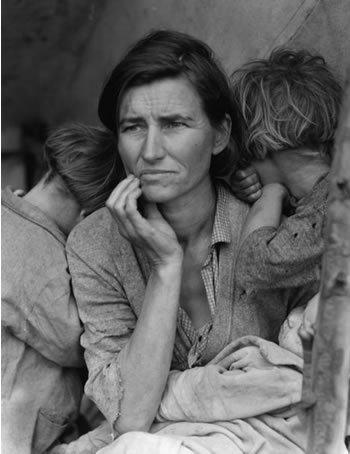
"Mother of immigrants," Dorothea Lange 1936
If we talk about the pictures that define certain era of human history, this has become for many the personification of the era of the Great Depression. Florence Owen Thompson became the face of this era thanks to the legendary Dorothea Lange, visited California camp Pea Pickers in February 1936 and showed a photograph of all the inflexibility and resistance of the people in these difficult times.
Incredibly, the history of Florence Thompson also exceptional as her portrait. At the time the picture she was 32 years old, she had seven children, and her husband died of tuberculosis. Coming to work in Nipomo, California, her family ate birds that managed to catch the children, and vegetables from the neighboring field -Just life and were still two and a half thousand workers who lived there.
The effect of the photos was a runaway -smotrevshee with newspaper pages face Florence led to an immediate public response, forcing authorities to send food and other assistance. However, by the time of Florence with his family has moved from the old place, so the blessings of the state walked by her side. Until 1976, no one knew that the woman depicted in the picture, while in a newspaper interview, Florence did not name himself.
3. The photo that showed the war every
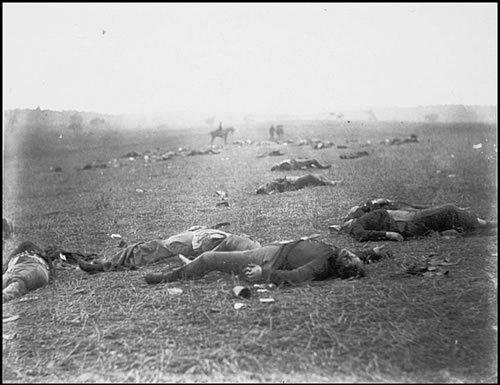
"The soldiers who fell on the battlefield in the first day of the Battle of Gettysburg, Pennsylvania," Mathew Brady, 1863
Career of one of the first war photographers, Mathew Brady, was not as eventful as you would expect. Dagerrotipist successful and distinguished gentleman, Brady was known portraits of famous people -Avraama Lincoln and Robert E. Lee.
In other words, as a photojournalist, he did not climb the trenches. In fact Brady is at stake all that he had, when he decided to change his life -Custom money, business, even life. Still, he decided, and went with the soldiers into battle, taking a camera. Just how sharp is the bayonet, Brady knew firsthand.
Miraculously escaped death in the first battle, he cooled down a little and continue had sent in his place assistants. For several years Brady and his team have done more than seven thousand photos -porazitelno, especially when you consider that for the manufacture of photos required bulky equipment and a whole cartload of chemicals. Far from "Polaroid".
Brady Pictures, which he did in a poorly adapted for this mobile darkroom, nevertheless perfectly reflect a time when Americans had to face for the first time with the grim reality of war.
4. Photography, which ended the war, but broke life
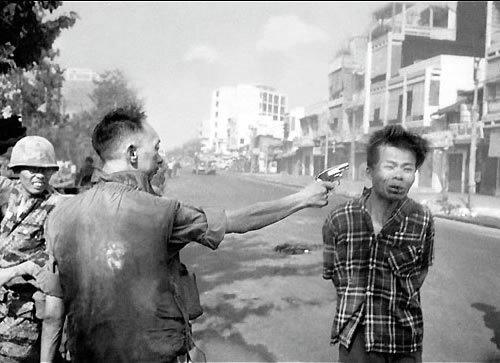
"The murder of Vietnamese Saigon police chief," Eddie Adams, 1968
"Frozen moments in photos -navernoe, the most powerful weapon in the world" once -napisal photographer Eddie Adams. Note the more apt that a photograph taken by him in 1968, at which the officer shot in the head handcuffed prisoner, not only earned him the Pulitzer Prize in 1969, but not the most pleasant way changed the idea of the American war in Vietnam.
Despite the fact that the resonance caused by the image, was huge, the situation was not as straightforward. Photo does not report that the prisoner was the leader of group "Avengers" that this very day was killed several dozen civilians. However, the picture immediately became a visual representation of the atrocities of war, and the officer pulls the trigger -general Nguyễn Ngọc Loan -odioznym villain.
Sadly, this photo is the most unlucky influenced the fate of the general. Even after the war, he was insulted and blasphemed. After it refused to treat an Australian military hospital, he was sent to the US, where he was met by mass, albeit an unsuccessful campaign demanded his deportation. In the end, he settled in Virginia and opened a restaurant, which he soon had to close when the rumors about his past and reached this place. Vandals wrote on the walls of the restaurant: "We know who you are", and business, of course, did not go.
Adams felt very sorry for Lohan, he apologized for the fact that in general took a picture, saying that: "The general killed a Vietnamese, and I killed my camera General."
5. Photo, romance is really exaggerated.
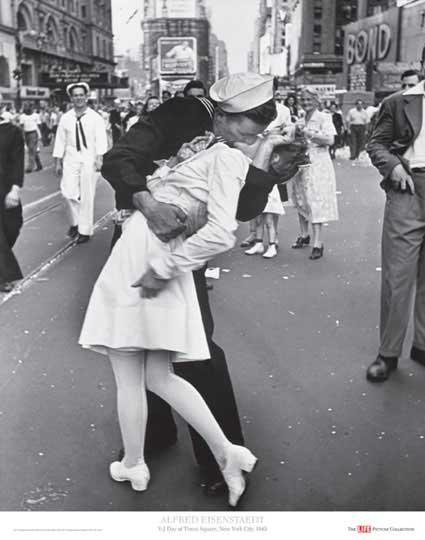
"Times Square 1945", also known as "The Kiss". Alfred Eisenstaedt, 1945
August 14, 1945 in the United States learned of the surrender of Japan, mean the end of the Second World War. On the streets of a rapidly celebrated, and most of all happy, of course, the soldiers. Despite the fact that many of them only recently returned with a victory in Europe, they had to re-sail-on this time hated by the Pacific Ocean.
Among celebrate, gathered in Times Square that day was also a talented photographer, a German immigrant Alfred Eisenstaedt. Removing the camera on holiday, he noticed a sailor, who ran down the street and shoveled in his arms each met the woman. As he spoke Eisenstadt, "it does not matter, it was old or young, fat, skinny, beautiful or not -emu did not care."
Of course, the photo sailor kissing a fat old woman on the cover of Life will not fit, but shot a sailor with a pretty nurse circled headlines across the country.
Needless to say that the picture captured is not the long-awaited moment of meeting people loving each other and at the same time it does not seem theatrical, no matter what the critics. In any case, the picture remains a symbol of everlasting joy America after the end of a long war.
6. Photography, destroyed the entire industry.

"Hindenburg" Murray Becker 1937
Forget about the "Titanic", "Lusitania" and solely inphotogenic Chernobyl disaster. Due to the tremendous expressive images, the collapse of "Hindenburg", which took place May 6, 1937, acquired the dubious honor of the worst disasters of the 20th century.
From the point of view of eternity, a disaster, of course, is not so global. Of the 97 people on board escaped a surprising number of -62. In general, it is not even the worst thing zeppelin crash in this century. Four years earlier, the American airship "Akron" crashed into the Atlantic Ocean, taking with him, at least twice as many lives. However, -who remembers "Akron" ?!
Become part of a massive advertising campaign "zeppelin", this flight "Hindenburg" was covered by dozens of reporters, photographers and journalists. Airship landing was planned in Lakehurst, New Jersey, but because of the bad weather delayed the landing. When the airship moored near to a special mast, there was an explosion. The public around the world was shocked by what had happened, unshakable faith in the reliability of "zeppelin", who was then the safest means of aeronautics, shaken, and the company soon stopped the creation of airships.
In the years 1920 -1930 "zeppelin" made regular flights between Germany and America. It stopped in 1937, after the disaster. One case led to the collapse of manufacturing industry wei airships as commercially viable means of passenger transportation. The golden age of airships ended not faint whimper, and a deafening explosion, which saw pictures of the whole world.
7. photography, which saved the planet
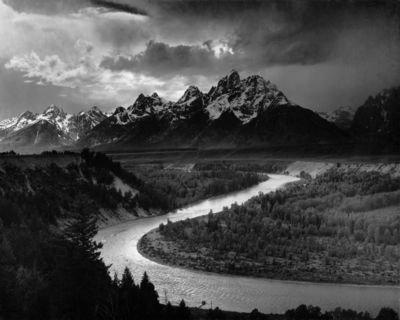
"Valley of the Snake River" Ansel Adams 1942
They say that the whole history of photography can be divided into two periods -up Adams and beyond. Before him, such as a photograph is considered a form of art but a few. Instead, the images have tried every conceivable way to embellish -One needle scraping negatives, other gasoline smeared lenses. Then came Adams, show pictures of the world, how to get rid of such nemoschi.On swept aside the old tricks, including their appendages of other art forms. Instead, he worked for the glory of "pure photography".
At a time when more or less modern cameras are no longer a rarity, Adams and other landscape photographers still shot on his huge clumsy camera. And it did work Adams photo art. Moreover, they forced people to think about the beauty of nature and how to preserve it.
Adams passion for land that is not limited to one fotografironiem. In 1936 he sent his photos to Washington to hold a campaign for the preservation of one of the areas of California -Korolevskogo canyon. All went well, and the area became a national park.
8. Photograph that "resurrect" Che
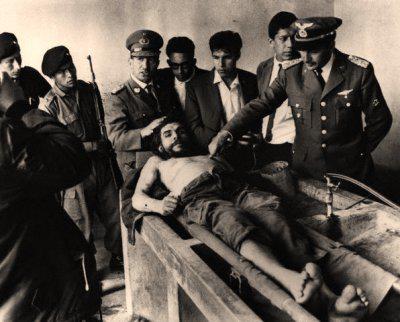
"The body of Che Guevara," Freddie Alborta 1967
Thug-sociopath? Icon of socialism? Or existentialist Jean-Paul Sartre was right, calling Che "a real man era"? Who Whatever you believe, there is no denying that Ernesto "Che" Guevara has become a kind of patron saint of revolutionaries. He gained a reputation as a mythical god or hero-even not so much with his life as his death.
Enraged by his attempts to raise the revolution of the poor and oppressed of Bolivia, the troops of the national army of the country (CIA trained and equipped with American weapons) captured Che Guevara captured and executed in 1967. However, before you bury it in a secret place, they gathered for the strategic picture next to his body-is necessary to demonstrate to the world that Che is dead. With him, it was hoped the initiators and executors of the murder must die and his political movement. Moreover, the fear of being accused of faking photos, killer amputated the hands of Che Guevara and put them in formaldehyde.
However, killing him, Bolivian authorities did not help Che legend. Photographer who saw the whole world, strangely resembles the image of Christ removed from the cross. Despite the fact that the murderer Che mock and scoff at him (the officer on the right shows the wound in the right side of Che Guevara), the expression on his face seems calm and serene. Allegory pictures did not fail to take advantage of the revolutionaries. They quickly came up with the slogan "Che lives!". Largely thanks to this picture, he will be remembered as a martyr of the revolution.
9. photography, which argues that the genius and not without a sense of humor.
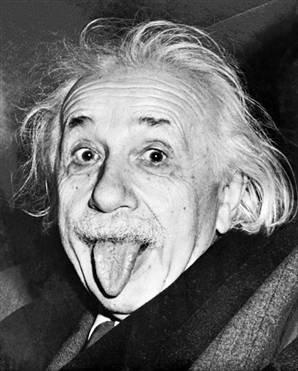
"Einstein, showing the language," Arthur Sasse, 1951
Photography, of course, interesting, but natural to ask what's so outstanding? Einstein changed the history of his work in nuclear physics and quantum mechanics, but this picture changed the idea of himself. So a person who is perceived only as a genius, saw a human. Probably because of this picture Einstein's name has become synonymous not just a genius, a genius of the original.
So how did get this picture? Professor Einstein hoped peacefully to meet its 72 birthday, I could not get out of Princeton University. In addition, the press did not give him no rest. When he was a hundred thousand times asked to smile at the camera, he demonstrated the photographer language almost to the root. Photos of genius with his tongue hanging out instantly became public and the kind of classic, so that the Nobel laureate remembered not only for his intelligence, but also his personality.
10. Photos taken surrealism reality
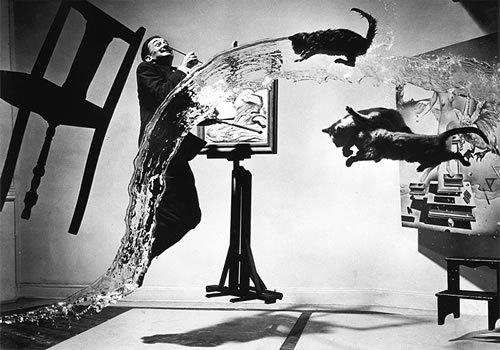
"Atomic Dali", Philip Haltsman 1948
Philip Haltsman probably edinstvennny photographer who made his name photographing people jumping. He argues that in the jump reveals the true nature of the persons concerned. Looking for one of his most famous pictures, "Atomic Dali", it is difficult not to agree.
This picture is a tribute of respect for the nuclear era (beginning she put the discovery that all matter is suspended) and the surreal Dali masterpiece "Leda Atomica" (in the picture it is located directly behind the cats, unfinished as it was at the time the pictures). To get this shot took six hours and 28 jumps and a whole army of assistants who threw cats and angry after they splashed water from buckets.
Before "Atomic Dali" has become what we know it, Haltsman dismissed a dozen concepts picture. So, it was supposed to pour milk instead of water, but the idea refused, fearing that the audience has not yet recovered from the hardships of war, poorly perceive such wasteful handling of milk. Another suggested blow cat to show it in a more or less atomic vzveshennnom state, but it would be, to say the least, wasteful in relation to cats.
The idea and execution Haltsmana were spectacular and unique. Pictures of celebrities jumping appeared on the cover of Life, at least seven times and opened a new, experimental and daring era portrait photography.
11. Photography, which lies
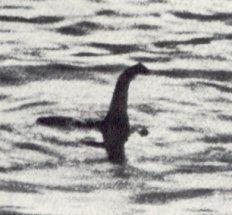
"Loch Ness monster" or "Photo Surgeon" 1934
Despite the fact that over the bleak Scottish Loch Ness oddities were carried out from the middle of the 6th century AD, allegedly afraid of monsters living in it really began only after how to get there photo. Known (in particular, its vagueness) the picture was taken, as claimed, in April 1934. Then there were the decade of fierce debate, several costly underwater expeditions, and, of course, an unprecedented flow of tourists annually bring millions of dollars in profits.
Almost all ended in 1994, when a report was published by Christian Sperling that the photo was fake. According to Sperling, his stepfather, Marmaduke Uezerell, was hired by the newspaper Daily Mail, to find the monster. when the search was to no avail, was made -from toy model motor boat and pieces of wood. In fact, the photo did Ian, a native son of Marmaduke Uezerella, but they convinced the famous surgeon Robert Wilson to declare it their own.
The camera, as the saying goes, never lies. But people-too often.
12 photos that could have been avoided.
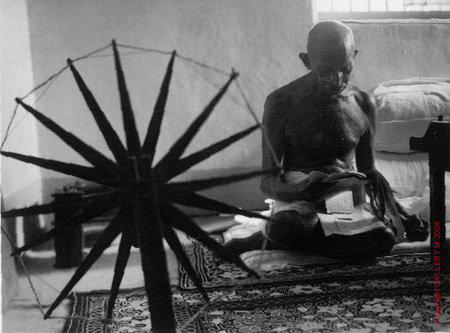
"Gandhi of the spinning wheel" Margaret Bourke-White, 1946
"Gandhi of the spinning wheel," a portrait of one of the most prominent and influential people of the twentieth century, could never be made because of the harsh demands of Mahatma Gandhi.
Photographer Margaret Bourke-White, was delighted rare opportunity to photograph the Indian leader and are ready to shoot, assistants Gandhi severely besieged if it is going to take pictures with the Mahatma spinning wheel, it must itself be able to handle it.
In this ease does not end there. With an ascetic Gandhi could not speak (just as he had a day of silence), and because of his dislike of bright light, the photographer was forbidden to use the flash.
Somehow compromise, Margaret faced another problem -vlazhnaya Indian pogolda brought her equipment in a complete mess. When she started to take off, refused to flash. On the second time she did not rewind the tape.
It has already begun to despair, but the third shot was successful. In the end, it was a picture of her was the most famous image of Gandhi. It was one of the last pictures in his life -less two years later he was killed.
13. Photography, anticipate the future.
"Violin Ingres" Man Ray, 1924
When Photoshop to anyone else and did not dream, Man Ray had already made stunning pictures. One of the original photos in the world, Man Ray was an avid experimenter. His ingenuity has often led to the fact that he was leaving the camera and created his masterpieces exclusively in a dark room.
1. Photography, photographers who raised to new heights.

«Omaha Beach, Normandy, France," Robert Capa, 1944
"If your pictures are not good enough, then you are too far away," 'said a military photographer Robert Capa. Pretty tough, but he knew what he was talking about. In the end, his most famous pictures he made June 6, 1944, when he went into the front ranks of the infantry at Omaha Beach. Caught off guard hurricane bombardment, Capa shot in the water until the end of the film. He miraculously managed to get out alive.
Of the four rolls of film that Capa photographed, managed to get only 11 frames -ostalnye spoiled assistant, who tried to show the film in a hurry to catch pass the images to the output of the next issue of the magazine Life.
Ironically, because of the same error remaining pictures got his famous "surreal view" -as wrongly interpreted Life, «slightly out of focus." More than fifty years later, director Steven Spielberg will make a huge effort to reproduce the same "wrong" effect in the film "Saving Private Ryan" -one even shot with the lens cover to get similar shots.
2. A photograph, which has become the personification of the Great Depression

"Mother of immigrants," Dorothea Lange 1936
If we talk about the pictures that define certain era of human history, this has become for many the personification of the era of the Great Depression. Florence Owen Thompson became the face of this era thanks to the legendary Dorothea Lange, visited California camp Pea Pickers in February 1936 and showed a photograph of all the inflexibility and resistance of the people in these difficult times.
Incredibly, the history of Florence Thompson also exceptional as her portrait. At the time the picture she was 32 years old, she had seven children, and her husband died of tuberculosis. Coming to work in Nipomo, California, her family ate birds that managed to catch the children, and vegetables from the neighboring field -Just life and were still two and a half thousand workers who lived there.
The effect of the photos was a runaway -smotrevshee with newspaper pages face Florence led to an immediate public response, forcing authorities to send food and other assistance. However, by the time of Florence with his family has moved from the old place, so the blessings of the state walked by her side. Until 1976, no one knew that the woman depicted in the picture, while in a newspaper interview, Florence did not name himself.
3. The photo that showed the war every

"The soldiers who fell on the battlefield in the first day of the Battle of Gettysburg, Pennsylvania," Mathew Brady, 1863
Career of one of the first war photographers, Mathew Brady, was not as eventful as you would expect. Dagerrotipist successful and distinguished gentleman, Brady was known portraits of famous people -Avraama Lincoln and Robert E. Lee.
In other words, as a photojournalist, he did not climb the trenches. In fact Brady is at stake all that he had, when he decided to change his life -Custom money, business, even life. Still, he decided, and went with the soldiers into battle, taking a camera. Just how sharp is the bayonet, Brady knew firsthand.
Miraculously escaped death in the first battle, he cooled down a little and continue had sent in his place assistants. For several years Brady and his team have done more than seven thousand photos -porazitelno, especially when you consider that for the manufacture of photos required bulky equipment and a whole cartload of chemicals. Far from "Polaroid".
Brady Pictures, which he did in a poorly adapted for this mobile darkroom, nevertheless perfectly reflect a time when Americans had to face for the first time with the grim reality of war.
4. Photography, which ended the war, but broke life

"The murder of Vietnamese Saigon police chief," Eddie Adams, 1968
"Frozen moments in photos -navernoe, the most powerful weapon in the world" once -napisal photographer Eddie Adams. Note the more apt that a photograph taken by him in 1968, at which the officer shot in the head handcuffed prisoner, not only earned him the Pulitzer Prize in 1969, but not the most pleasant way changed the idea of the American war in Vietnam.
Despite the fact that the resonance caused by the image, was huge, the situation was not as straightforward. Photo does not report that the prisoner was the leader of group "Avengers" that this very day was killed several dozen civilians. However, the picture immediately became a visual representation of the atrocities of war, and the officer pulls the trigger -general Nguyễn Ngọc Loan -odioznym villain.
Sadly, this photo is the most unlucky influenced the fate of the general. Even after the war, he was insulted and blasphemed. After it refused to treat an Australian military hospital, he was sent to the US, where he was met by mass, albeit an unsuccessful campaign demanded his deportation. In the end, he settled in Virginia and opened a restaurant, which he soon had to close when the rumors about his past and reached this place. Vandals wrote on the walls of the restaurant: "We know who you are", and business, of course, did not go.
Adams felt very sorry for Lohan, he apologized for the fact that in general took a picture, saying that: "The general killed a Vietnamese, and I killed my camera General."
5. Photo, romance is really exaggerated.

"Times Square 1945", also known as "The Kiss". Alfred Eisenstaedt, 1945
August 14, 1945 in the United States learned of the surrender of Japan, mean the end of the Second World War. On the streets of a rapidly celebrated, and most of all happy, of course, the soldiers. Despite the fact that many of them only recently returned with a victory in Europe, they had to re-sail-on this time hated by the Pacific Ocean.
Among celebrate, gathered in Times Square that day was also a talented photographer, a German immigrant Alfred Eisenstaedt. Removing the camera on holiday, he noticed a sailor, who ran down the street and shoveled in his arms each met the woman. As he spoke Eisenstadt, "it does not matter, it was old or young, fat, skinny, beautiful or not -emu did not care."
Of course, the photo sailor kissing a fat old woman on the cover of Life will not fit, but shot a sailor with a pretty nurse circled headlines across the country.
Needless to say that the picture captured is not the long-awaited moment of meeting people loving each other and at the same time it does not seem theatrical, no matter what the critics. In any case, the picture remains a symbol of everlasting joy America after the end of a long war.
6. Photography, destroyed the entire industry.

"Hindenburg" Murray Becker 1937
Forget about the "Titanic", "Lusitania" and solely inphotogenic Chernobyl disaster. Due to the tremendous expressive images, the collapse of "Hindenburg", which took place May 6, 1937, acquired the dubious honor of the worst disasters of the 20th century.
From the point of view of eternity, a disaster, of course, is not so global. Of the 97 people on board escaped a surprising number of -62. In general, it is not even the worst thing zeppelin crash in this century. Four years earlier, the American airship "Akron" crashed into the Atlantic Ocean, taking with him, at least twice as many lives. However, -who remembers "Akron" ?!
Become part of a massive advertising campaign "zeppelin", this flight "Hindenburg" was covered by dozens of reporters, photographers and journalists. Airship landing was planned in Lakehurst, New Jersey, but because of the bad weather delayed the landing. When the airship moored near to a special mast, there was an explosion. The public around the world was shocked by what had happened, unshakable faith in the reliability of "zeppelin", who was then the safest means of aeronautics, shaken, and the company soon stopped the creation of airships.
In the years 1920 -1930 "zeppelin" made regular flights between Germany and America. It stopped in 1937, after the disaster. One case led to the collapse of manufacturing industry wei airships as commercially viable means of passenger transportation. The golden age of airships ended not faint whimper, and a deafening explosion, which saw pictures of the whole world.
7. photography, which saved the planet

"Valley of the Snake River" Ansel Adams 1942
They say that the whole history of photography can be divided into two periods -up Adams and beyond. Before him, such as a photograph is considered a form of art but a few. Instead, the images have tried every conceivable way to embellish -One needle scraping negatives, other gasoline smeared lenses. Then came Adams, show pictures of the world, how to get rid of such nemoschi.On swept aside the old tricks, including their appendages of other art forms. Instead, he worked for the glory of "pure photography".
At a time when more or less modern cameras are no longer a rarity, Adams and other landscape photographers still shot on his huge clumsy camera. And it did work Adams photo art. Moreover, they forced people to think about the beauty of nature and how to preserve it.
Adams passion for land that is not limited to one fotografironiem. In 1936 he sent his photos to Washington to hold a campaign for the preservation of one of the areas of California -Korolevskogo canyon. All went well, and the area became a national park.
8. Photograph that "resurrect" Che

"The body of Che Guevara," Freddie Alborta 1967
Thug-sociopath? Icon of socialism? Or existentialist Jean-Paul Sartre was right, calling Che "a real man era"? Who Whatever you believe, there is no denying that Ernesto "Che" Guevara has become a kind of patron saint of revolutionaries. He gained a reputation as a mythical god or hero-even not so much with his life as his death.
Enraged by his attempts to raise the revolution of the poor and oppressed of Bolivia, the troops of the national army of the country (CIA trained and equipped with American weapons) captured Che Guevara captured and executed in 1967. However, before you bury it in a secret place, they gathered for the strategic picture next to his body-is necessary to demonstrate to the world that Che is dead. With him, it was hoped the initiators and executors of the murder must die and his political movement. Moreover, the fear of being accused of faking photos, killer amputated the hands of Che Guevara and put them in formaldehyde.
However, killing him, Bolivian authorities did not help Che legend. Photographer who saw the whole world, strangely resembles the image of Christ removed from the cross. Despite the fact that the murderer Che mock and scoff at him (the officer on the right shows the wound in the right side of Che Guevara), the expression on his face seems calm and serene. Allegory pictures did not fail to take advantage of the revolutionaries. They quickly came up with the slogan "Che lives!". Largely thanks to this picture, he will be remembered as a martyr of the revolution.
9. photography, which argues that the genius and not without a sense of humor.

"Einstein, showing the language," Arthur Sasse, 1951
Photography, of course, interesting, but natural to ask what's so outstanding? Einstein changed the history of his work in nuclear physics and quantum mechanics, but this picture changed the idea of himself. So a person who is perceived only as a genius, saw a human. Probably because of this picture Einstein's name has become synonymous not just a genius, a genius of the original.
So how did get this picture? Professor Einstein hoped peacefully to meet its 72 birthday, I could not get out of Princeton University. In addition, the press did not give him no rest. When he was a hundred thousand times asked to smile at the camera, he demonstrated the photographer language almost to the root. Photos of genius with his tongue hanging out instantly became public and the kind of classic, so that the Nobel laureate remembered not only for his intelligence, but also his personality.
10. Photos taken surrealism reality

"Atomic Dali", Philip Haltsman 1948
Philip Haltsman probably edinstvennny photographer who made his name photographing people jumping. He argues that in the jump reveals the true nature of the persons concerned. Looking for one of his most famous pictures, "Atomic Dali", it is difficult not to agree.
This picture is a tribute of respect for the nuclear era (beginning she put the discovery that all matter is suspended) and the surreal Dali masterpiece "Leda Atomica" (in the picture it is located directly behind the cats, unfinished as it was at the time the pictures). To get this shot took six hours and 28 jumps and a whole army of assistants who threw cats and angry after they splashed water from buckets.
Before "Atomic Dali" has become what we know it, Haltsman dismissed a dozen concepts picture. So, it was supposed to pour milk instead of water, but the idea refused, fearing that the audience has not yet recovered from the hardships of war, poorly perceive such wasteful handling of milk. Another suggested blow cat to show it in a more or less atomic vzveshennnom state, but it would be, to say the least, wasteful in relation to cats.
The idea and execution Haltsmana were spectacular and unique. Pictures of celebrities jumping appeared on the cover of Life, at least seven times and opened a new, experimental and daring era portrait photography.
11. Photography, which lies

"Loch Ness monster" or "Photo Surgeon" 1934
Despite the fact that over the bleak Scottish Loch Ness oddities were carried out from the middle of the 6th century AD, allegedly afraid of monsters living in it really began only after how to get there photo. Known (in particular, its vagueness) the picture was taken, as claimed, in April 1934. Then there were the decade of fierce debate, several costly underwater expeditions, and, of course, an unprecedented flow of tourists annually bring millions of dollars in profits.
Almost all ended in 1994, when a report was published by Christian Sperling that the photo was fake. According to Sperling, his stepfather, Marmaduke Uezerell, was hired by the newspaper Daily Mail, to find the monster. when the search was to no avail, was made -from toy model motor boat and pieces of wood. In fact, the photo did Ian, a native son of Marmaduke Uezerella, but they convinced the famous surgeon Robert Wilson to declare it their own.
The camera, as the saying goes, never lies. But people-too often.
12 photos that could have been avoided.

"Gandhi of the spinning wheel" Margaret Bourke-White, 1946
"Gandhi of the spinning wheel," a portrait of one of the most prominent and influential people of the twentieth century, could never be made because of the harsh demands of Mahatma Gandhi.
Photographer Margaret Bourke-White, was delighted rare opportunity to photograph the Indian leader and are ready to shoot, assistants Gandhi severely besieged if it is going to take pictures with the Mahatma spinning wheel, it must itself be able to handle it.
In this ease does not end there. With an ascetic Gandhi could not speak (just as he had a day of silence), and because of his dislike of bright light, the photographer was forbidden to use the flash.
Somehow compromise, Margaret faced another problem -vlazhnaya Indian pogolda brought her equipment in a complete mess. When she started to take off, refused to flash. On the second time she did not rewind the tape.
It has already begun to despair, but the third shot was successful. In the end, it was a picture of her was the most famous image of Gandhi. It was one of the last pictures in his life -less two years later he was killed.
13. Photography, anticipate the future.
"Violin Ingres" Man Ray, 1924
When Photoshop to anyone else and did not dream, Man Ray had already made stunning pictures. One of the original photos in the world, Man Ray was an avid experimenter. His ingenuity has often led to the fact that he was leaving the camera and created his masterpieces exclusively in a dark room.











